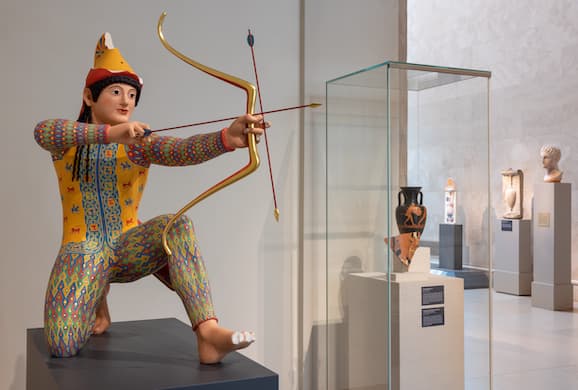The Met Gets a Paint Job
It is not easy to say what ‘Chroma’ is, other than that it might be the future, and it transpires in part on your phone.

It is not easy to say what “Chroma: Ancient Sculpture in Color” is, other than that it might be the future, and it transpires in part on your phone. The show is more a concept than a catalog, with one foot in Alternative Reality and the other on Fifth Avenue. Nevertheless, it gives color to the past, which could yet prove to be an important task for a visually addled present.
“Chroma,” at the Metropolitan Museum of Art through March, takes as its subject “polychromy,” which simply means “many colors.” Think Joseph’s coat. In the museum’s words, though, it “highlights cutting-edge scientific methods used to identify ancient color and examines how color helped convey meaning in antiquity.”
A visitor does not even need to wander over to the sculptures of antiquity to access “Chroma.” A QR code at the information desk helpfully allowed this reviewer to conjure a three-dimensional sphinx on his phone while waiting for tickets, no doubt terrifying a gaggle of tourists in the process. The sphinx made a long journey to my screen, as it dates from 530 before the common era.
Another feature on the app, which you can access at home as easily as at the Met, allows the superimposition of filters derived from the exhibit onto selfies that can then be shared via email and Instagram. Why merely look at a work of art when with the help of Steve Jobs’s masterpiece, one can be a work of art? Could all of us someday be hanging in the meta of the Met?
Finding the “Chroma” displays would be easier if the app included a GPS. Scattered around the sculpture hall are colorful reproductions, sometimes adjacent to the originals and occasionally orphaned from their models by geography. They serve to remind that what Edgar Allan Poe called “the glory that was Greece” was not always alabaster.
Seeing the bright colors that the husband and wife team of Vinzenz Brinkmann and Ulrike Koch-Brinkmann lavish on their reconstructions using “a wide array of analytical techniques, including 3D imaging and rigorous art historical research,” can be jarring, a reminder that the past did not see itself in black and white, just as the people in old newsreels saw color where we see shades.
One reconstruction, of the “Cuirassed Torso from the Athenian Acropolis,” is of an almost blinding gold with bright red and blue trimming, and surely was a riot of color on the battlefield. (On today’s battlefields, it would be banned as too visible to satellites). It conjures images of war as a matrix of pigmentation, a pageant rather than a clash of browns and steel gray.
The “Reconstruction of the Marble Funerary Statue of Phrasikleia,” whose original is at Athens, greets the visitor as a vertical homage to red, with curls cascading onto a dress speckled with yellow and green details, sleeves bordered with a snaking gold design. Stopping by to see her during New York Fashion Week did not feel inappropriate.
“Reconstruction of a Marble Archer,” built from natural pigments in egg tempura, tin, wood, and gold leaf, illustrates the style with which even these assassins dressed. Surely camouflage was not a priority for this bright-yellow-clad marksman with a red sheath and colorful sleeves. With heels bent, back arched, and arms taut, he is ready to let loose a deadly arrow.
Not all of the displays feature such sartorial splendor. “Reconstruction of Bronze Riace Warrior A and B” depicts two nude fighters coiled and ready for combat, one with a silver helmet and the other with a gold helmet. The real showstopper is the use of bronze and copper to craft skin that feels like it is still pulsing with life and warm to the touch.
The Brinkmanns’ “Small Herculaneum Woman,” who originates at Delos, is a contrast to that chiseled duo, shrouded in a flowing aqua green mantle that gives way to pink and sky blue undertones. This is a woman who is striking but not garish, borrowing something of the palette of the Aegean Sea itself. The “Reconstruction of the Chios Kore,” on the other hand, is vivid and ceremonial, almost solar in her splendor.
The Met has set aside a room, Gallery 172, for a deep dive into how the Brinkmanns build their reconstructions. It also features a potted history of the museum’s exploration of color, now also visible on the hieroglyphs that adorn the Temple of Dendur. These are likely to compel only those already initiated into the esoterica of digital imaging and model building. Spend time instead with the works themselves, both lovely and kitschy.
The Met’s director, Max Hollein, notes that for some, seeing the past bathed in color “will be a shock.” That surprise abides alongside gratitude for the charisma of bare marble, leached of color and enduring. I lingered in front of “Marble Head from the Figure of a Woman,” from the Bronze Age, nearly six millennia ago. She was once painted, once whole. Now she is effaced, almost abstract, and entirely magnificent.

